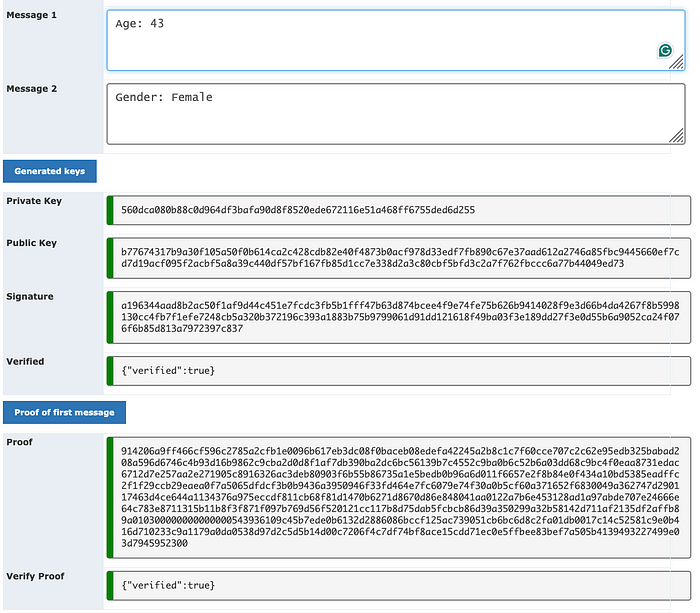身份不应被强制
- asecuritysite
- 发布于 2025-06-08 16:49
- 阅读 1028
本文讨论了数字身份验证的问题,分析了英国政府强制推行数字身份的潜在风险,并介绍了欧盟开放数字钱包的方法。文章重点介绍了如何使用BBS签名和JavaScript集成WASM,以实现政府对身份属性的签名,并允许公民选择性地展示身份信息的特定部分,从而保护隐私。最后提供了一个使用WASM和JavaScript创建BBS+签名的示例。

身份不应被强加
我听说英国政府正在考虑强制公民拥有数字身份,并在被要求时出示。嗯,这种方法在 2001 年就失败了,当时托尼·布莱尔提出的方案因担心政府机构会监视公民而被放弃。因此,英国政府可能正在为自己设置另一个陷阱,而不是宣传使用政府来源证明身份的巨大好处。不过,欧盟正在采取不同的策略,促使数字钱包的开放性,政府只是其中一个身份提供者 —— 而且是一个高度信任的提供者。为此,公民或组织的公钥将被放置在 EBSI 区块链上,然后可以使用存储在钱包中的私钥来签署消息,这些消息将通过受信任的公钥进行验证。
虽然公民方面的管理和设置稍微困难一些,但企业注册部分相当容易,并且存在公钥注册的受信任流程。一个很好的例子是大学授予学术资格,并且会授予数字证书,该证书由大学签署,并且公钥将放置在 EBSI 账本上,然后由任何其他实体验证。
但是,政府派生身份的问题在于,政府通常会签署一系列身份属性,并且在大多数情况下,我们只需要展示其中一个或多个(例如我们的地址)。为此,我们可以使用 BBS 签名,政府签署身份证明,然后公民可以展示他们想要的已证明身份的部分。
在下文中,我们将使用 BBS 签名和 JavaScript,集成 WASM,然后生成一个总签名(来自政府),并将其颁发给 Peggy。然后,她可以获取其中一个属性,并生成一个可以针对主签名进行测试的证明 [here]:
<style>
.dropdown {
font-size: 16px;
border: 2px solid grey;
width: 100%;
border-left: 12px solid green;
border-radius: 5px;
padding: 14px;
}
pre {
font-size: 16px;
border: 2px solid grey;
width: 100%;
border-left: 12px solid green;
border-radius: 5px;
padding: 14px;
}
textarea {
font-size: 20px;
border: 2px solid grey;
width: 100%;
border-radius: 5px;
padding: 14px;
}
</style>
<div class="indented">
<h2>BBS+</h2>
<table width="100%">
<tr>
<th width="15%" valign="top">生成密钥</th>
<td style="text-align:left">
<p>
<input id="genkey" class="btn btn-large btn-primary" type="button" value="重新生成密钥" />
</p>
</td>
</tr>
<tr>
<th width="15%" valign="top">消息 1</th>
<td>
<textarea cols="20" id="message1" name="message1" rows="1" style="width:100%"></textarea>
</td>
</tr>
<tr>
<th width="15%" valign="top">消息 2</th>
<td>
<textarea cols="20" id="message2" name="message2" rows="1" style="width:100%"></textarea>
</td>
</tr>
</table>
<h2>生成的密钥</h2>
<table width="100%">
<tr>
<th width="15%" valign="top">私钥</th>
<td>
<pre id="PrivateKey"></pre>
</td>
</tr>
<tr>
<th width="15%" valign="top">公钥</th>
<td>
<pre id="PublicKey"></pre>
</td>
</tr>
<tr>
<th width="15%" valign="top">签名</th>
<td>
<pre id="Signature"></pre>
</td>
</tr>
<tr>
<th width="15%" valign="top">已验证</th>
<td>
<pre id="Verified"></pre>
</td>
</tr>
</table>
<h2>第一个消息的证明</h2>
<table>
<tr>
<th width="15%" valign="top">证明</th>
<td>
<pre id="proof"></pre>
</td>
</tr>
<tr>
<th width="15%" valign="top">验证证明</th>
<td>
<pre id="proof_verify"></pre>
</td>
</tr>
</table>
</div>
<script type="module">
function buf2hex(buffer) {
var u = new Uint8Array(buffer),
a = new Array(u.length),
i = u.length;
while (i--) // map to hex
a[i] = (u[i] < 16 ? '0' : '') + u[i].toString(16);
u = null; // free memory
return a.join('');
};
(async function () {
const docknetworkcryptoWasm = await import("https://cdn.jsdelivr.net/npm/@docknetwork/crypto-wasm@0.33.0/+esm");
async function update() {
// Load the WASM module
await docknetworkcryptoWasm.initializeWasm();
const message1 = new TextEncoder().encode(document.getElementById("message1").value);
const message2= new TextEncoder().encode(document.getElementById("message2").value);
// Generate some random msgs
const msgs = [\
new TextEncoder().encode(message1),\
new TextEncoder().encode(message2)\
];
const label = new TextEncoder().encode("My label");
const messageCount = msgs.length;
// The label generates deterministic params
const sigParams = docknetworkcryptoWasm.bbsPlusGenerateSignatureParamsG1(messageCount, label);
// Generate key pair
const sk = docknetworkcryptoWasm.bbsPlusGenerateSigningKey();
const pk = docknetworkcryptoWasm.bbsPlusGeneratePublicKeyG2(sk, sigParams);
document.getElementById('PrivateKey').innerText = buf2hex(sk);
document.getElementById('PublicKey').innerText = buf2hex(pk);
// Generate the signature
const sig = docknetworkcryptoWasm.bbsPlusSignG1(msgs, sk, sigParams, true);
document.getElementById('Signature').innerText = buf2hex(sig);
// Verify the signature
const isVerified = docknetworkcryptoWasm.bbsPlusVerifyG1(msgs, sig, pk, sigParams, true);
document.getElementById('Verified').innerText = JSON.stringify(isVerified);
// Set the first message to prove
const revealed = new Set();
revealed.add(0);
const revealedMsgs = new Map();
revealedMsgs.set(0, msgs[0]);
const proof_of_signature = docknetworkcryptoWasm.bbsPlusInitializeProofOfKnowledgeOfSignature(
sig,
sigParams,
msgs,
new Map(),
revealed,
true
);
// Define a challenge from the Prover
const prover_challenge = docknetworkcryptoWasm.generateChallengeFromBytes(docknetworkcryptoWasm.bbsPlusChallengeContributionFromProtocol(proof_of_signature, revealedMsgs, sigParams, true));
const proof = docknetworkcryptoWasm.bbsPlusGenProofOfKnowledgeOfSignature(proof_of_signature, prover_challenge);
document.getElementById('proof').innerText = buf2hex(proof);
// Verify the proof
const challengeVerifier = docknetworkcryptoWasm.generateChallengeFromBytes(docknetworkcryptoWasm.bbsPlusChallengeContributionFromProof(proof, revealedMsgs, sigParams, true));
const proof_verified = docknetworkcryptoWasm.bbsPlusVerifyProofOfKnowledgeOfSignature(
proof,
revealedMsgs,
challengeVerifier,
pk,
sigParams,
true,
);
const proof_verifiedString = JSON.stringify(proof_verified);
document.getElementById('proof_verify').innerText = JSON.stringify(proof_verified);
}
document.getElementById("message1").addEventListener("input", update);
document.getElementById("message2").addEventListener("input", update);
document.getElementById("message1").innerText = "Hello";
document.getElementById("message2").innerText = "Hello123";
document.getElementById("genkey").addEventListener("click", update);
update();
message1.focus();
})();
</script>一个示例运行显示了 Peggy 年龄的证明以及证明的验证:

演示在这里:
使用 WASM 和 JavaScript 为 BBS+ 签名创建证明 \ \ 我们能否为一组会员生成数字签名,从而无法知道谁签署了…\ \ asecuritysite.com
- 原文链接: medium.com/asecuritysite...
- 登链社区 AI 助手,为大家转译优秀英文文章,如有翻译不通的地方,还请包涵~
- 我检查了最差的运营安全实践,所以你不必亲自检查 178 浏览
- 隐私宣言 622 浏览
- ZK Mesh:2025年10月回顾 456 浏览
- 使用 LaserStream SDK 实现高性能 Solana 流式传输 1833 浏览
- Rarimo - 护照如何转变为数字身份 1692 浏览
- 如何在 JavaScript 中生成新的比特币地址 526 浏览
- 我们如何攻破交易所:身份验证和客户端漏洞深度剖析 695 浏览
- Canton Network 是什么? 1050 浏览
- QuickNode Marketplace入门指南 537 浏览
- ZK Mesh:2025年9月回顾 813 浏览
- 数字身份终于在英国出现 580 浏览
- 可信执行环境(TEE)解析:安全区块链应用的未来 988 浏览

